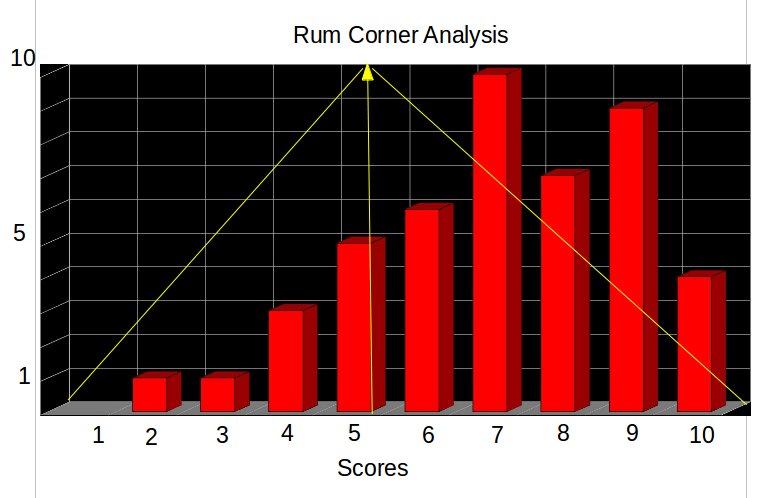. . . . . . .

I don't know how I ran across the “Rum Corner” but I'm both glad and sad I did. The glad part: here's a guy whose reviews are rather well written, and he seems to tell it like it is. He recognizes the sugar issue, but therein lies the problem. Apparently he feels there really are such things as “sweet rums” and the fact that this sweetness is the result of adulteration with copious amounts of sugar, et al, is well, just fine. So called “rums” like 1919, the Zee and Dee variety actually earn rather high ratings from him.
Which raises yet another issue. My god, what is it about these new and self-indulgent “reviewers” that causes them to adopt new, untested and unrecognized scoring systems? This when the Platinum Standard – the standard American grading system has been adopted by every serious reviewer of wine and spirits (and other things), beginning with the recognized father of the modern scoring system, Robert Parker. Parker uses a 100 point system, but the lowest score ever given is never less than “50”, the lowest score. It has been adopted as follows:
90-100: A or Five Stars, excellent
80-89: B or Four Stars, above average
70-79: C or Three Stars, average
60-69: D or Two Stars, below average (but passing)
50-59: F or One Star, failure.
Easy peasy, and absolutely everyone “gets” it. An absolutely average spirit will get a “75”. Period.
The Standard system is universal, and understood by everyone. There's simply no reason to install anything else without risking confusion and misunderstanding. Ergo, once again I am forced to interpret the Corner's system for you.
So how does the Corner score?
The Rum Corner has decided to use a 10 point system with one huge and glaring change. He runs his scores all the way down to 1 point; the lowest score he has given is just 2 points. This creates a real issue: his average score is “5” as designed (as he can ostensibly assign a score of “1”). His “average” is depicted by the vertical yellow arrow. Now consider the distribution. Based on his “average” score of “5”, if his scores were truly unbiased and followed a normal distribution, the same number of rums should appear on both sides of the average (which should be the largest score). Let's see what actually happens.
1. His largest score is “7” (10 rums), well above what should be his largest category, ie his “average” of “5” (just 5 rums).
2. Based on a total of 46 rums reviewed, an equal number of rums – 21 – should appear on either side of average. In his case the number of rums scoring less than average is just 5 rums, while the number scoring more than average is an amazing 36 rums. His bias is clear and rather extreme.
Flat Ass Bottom Line
From my point of view his negatives are: an acceptance of the idea of “sweet rums” no matter how achieved; his failure to dilute any rum regardless of proof; a focus on bottling, cases and labels; the acceptance of freebies for “review”; an inability to really define “super premiums” beyond price; and last, the belief for example, that an 8 year old rum is necessarily “entry level” (rather than the sweet spot of age). He has a clear bias toward expensive and premiumized releases and names his influences as including the Canadian boyz – both of em.
OTOH he is not devoid of positives. His reviews are to the point, decent palate, and he has no qualms about telling it like it is. He does recognize the use of sugar (even though he does not reject it), and does not hesitate to call out misrepresentation by the marketing monkeys. To the score, a hard one because I rather like this gentleman's reviews, and only because of these...
Score (10 is best): 7. Ignore the scoring and his bias toward age and price. A website and reviewer worth reading.
*******
http://www.rumcorner.dk/
